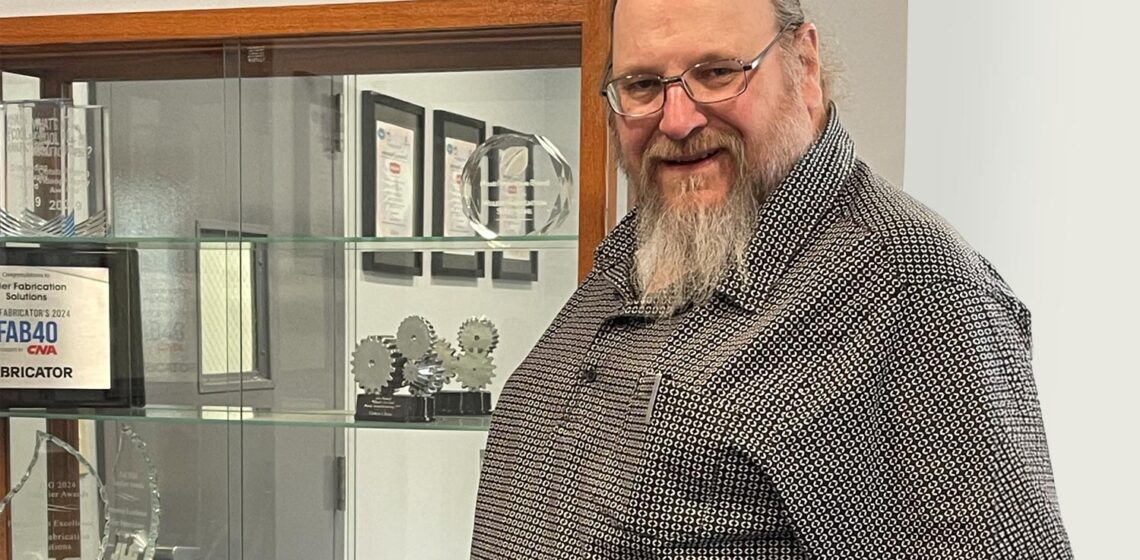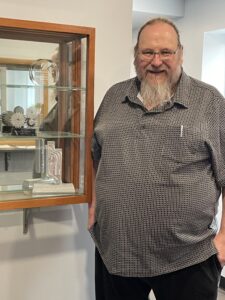
Mike Aaron: From Sweeping Floors to Steering Quality
June 16, 2025
When Mike Aaron joined Miller Fabrication Solutions in February 1981, he was a 17-year-old high school senior and, amid a brewing recession, he felt thankful for his new, part-time job as a floor sweeper. Turns out, Miller got pretty lucky, too, the day Mike joined the company. He has grown more valuable to us with each passing year.
Mike is still “sweeping the floors” at Miller in the sense that he remains hands-on in his dedication to the company, despite rising through many levels of responsibility since his humble beginnings 44 years ago.
As part of our ongoing series profiling longtime Miller employees, we sat down with Mike recently to talk about his career. Here are highlights from that conversation:
Q: What did you do at Miller after literally sweeping the floors in your first role, and what do you do now?

A: Well, I finally worked up enough nerve to ask the “big guy,” David R. Miller, for a full-time job running machines after I graduated from high school. The good news was he said ‘yes’ – but then I found out I had to buy all my own tools.
That’s what you had to do in those days. So, after a $3,500 bill at Sears for buying my machinist tools and toolbox, on credit, I showed up to work as a machine operator. I paid Sears around $80 per month for a long time to pay that off.
Funny story: My first task on the job was to change a tire on a forklift, which, of course, did not require a single one of my shiny new tools.
Now I’m a quality process manager. I work as a liaison between quality, engineering and production – a far cry from my confusing first day!
Q: But you stuck with it and rose through the ranks. Tell us about that.
A: I started at the bottom running a drill press, laying out bolt circles by hand. I went from that to lathes, ertical mills, Blanchard grinder, shapers and horizontal mills. From there, I moved toward the quality side of things as an inspector and calibrator, just slightly before the first CNC (computer numerical control) machine hit the production floor.
I love machining and technology, and I’m a dedicated-to-a-fault kind of person. I wanted to see and be a part of what Miller could become. It’s really been inspiring to see the commitment the Miller family has to our community – an area I love – through thick and thin. I wanted to go along on that ride.
Q: What has kept you at Miller all these years?
A: The friendships I’ve made are a big reason. Plus, I’ve always advanced here. When the opportunity came to be an inspector, I raised my hand because I love making and reading drawings. So, it was a good fit.
Then, as technology changed, so did my responsibilities. I also interacted a lot with customers, which I really enjoyed. I was in charge of problem-solving for them, which involved suggesting improvements that made things better for both of us. I had a lot of free rein to do what I thought was best, and nobody second-guessed me. One of the projects I am most proud of was developing all the processes and designs to bring in the backup roll chock business, a product we had lost to a competitor years earlier. Working with Hanco Inc., we got the business back and were quite successful with it for many years.
So that was another step up. I completed more training on drawings and GD&T (geometric dimensioning and tolerancing). For a while, I was the resident GD&T expert, not an enviable spot to be in.
I couldn’t fathom changing jobs like a lot of people do. I couldn’t imagine starting over again at the bottom. That idea horrified me, and I was always glad I had the dependability and security of working here.
Q: What are some of your favorite memories from your time working at Miller?
A: Well, there are lots of them. I’ve even started writing a book about some of my memories. One of the first things that comes to mind is how the floor sweepers were constantly digging ourselves out of the bins of metal scraps back in the day. When I was cleaning floors, you’d put everything you swept up in a wheelbarrow, push it up a narrow ramp 4 or 5 feet high, stop and dump.
If you had too much momentum at the top of the ramp, you didn’t always stop at the end. If you couldn’t stop, that meant the wheelbarrow and the wheelbarrow operating engineer (me) would go into the bin with all the rest of the metal chips. Our HR and safety people will read this and cringe! But back then, the only thing I could do was dig myself out or holler for a forklift operator to come pick me out. Good times…!
We also played practical jokes on each other. For a while, I worked the 11 p.m. to 7 a.m. shift. The winning lottery numbers were drawn at 7 p.m., and our foreman, Kevin, would get the winning numbers and drop them off on the toolbox of John, who played the lottery daily, so John could check his tickets.
Eventually, Kevin figured out what numbers John played. He told the rest of us that when he dropped the “winning” numbers off on John’s toolbox that night, they were going to be John’s numbers.
John thought he hit the jackpot. He slammed his toolbox shut, grabbed his lunchbox and ran out the door. He was gone! We had to go gather him up in the parking lot, and he was not a happy camper when he found out it was a prank.
Q: What would you tell people about what it’s like to work at Miller?
A: It will be what you want it to be. The only limitations if you work here are the ones you put on yourself. You always know where you stand. It’s a family-run business, of course, but people listen to you and respect you if you work hard and do a good job. I can’t imagine having spent my career anywhere else, and I’m grateful to Miller for all the opportunities I’ve had.